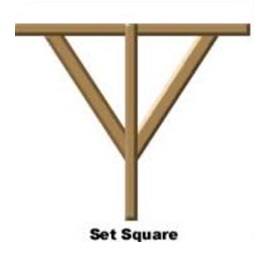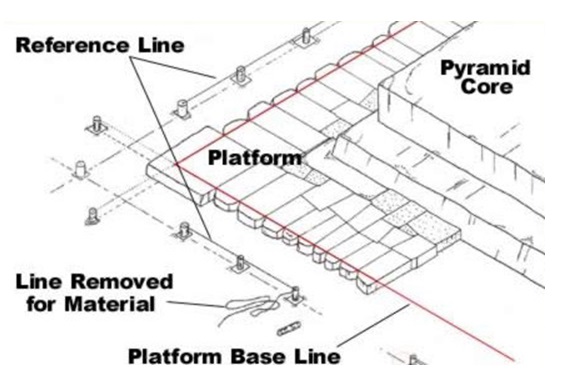Introduction
The ancient pyramids are part of the Seven Wonders of the World. The pyramids are huge and really wonderful to look at. The greatness of these huge structures does not just lie in their size but also in the architectural exactness with which they were constructed. It is a wonder that over time the modern man has found some of the most amazing geometry relationships in the dimensions of these great structures. This essay will make an attempt to bring into light some of the greatest wonders of the great pyramids including its geometry as depicted in the Great Pyramid.
Background Information
Simply defined a pyramid has a rectangular base and four triangular sides which are joined together to form a trapezoidal. In detail, it is “a monumental structure constructed of or faced with stone or brick and having a rectangular base and four sloping triangular (or sometimes trapezoidal) sides meeting at an apex (or truncated to form a platform)” (Pyramid 1). There are pyramids all over the world but this essay concentrates on those found in Egypt.
In ancient Egypt, pyramids were used as funeral edifices. It has been reported that they were built over a period of approximately 2, 700 years from the beginning of the “old kingdom to the close of the Ptolemaic period” (Pyramid 1). It has been pointed out that the climax of the pyramid construction was at the beginning of the third dynasty up to the sixth dynasty (Pyramid 1). Elsewhere, it has been pointed out that at the beginning of the third dynasty the pyramid was constructed with the sides being of several steps. During the fourth dynasty, the true pyramids were constructed. The true pyramids were an improvement of the several steps pyramid. The true pyramids did not have steps on their sides but rather were smooth. It has been pointed out that the pyramids have displayed sharp depictions of Pi. It is not yet understood how the Egyptians came up with this knowledge only that it is assumed they must have used drums to enable them to make some calculations (Tour Egypt 1).
Construction of the Pyramids
It has been reported that the construction of a pyramid was a huge work. Physical orientation and layout were only carried out after extensive planning had been done. Before construction would start there had to be plans drawn by some specialists. It is believed that models of the pyramids were made to aid in the construction process. It is said that when construction started it had to be initiated with a foundation ritual (Winston 1).
Plans for the Pyramids
Proper construction of the pyramids is said to have demanded strict cardinal point orientation. It is not properly understood how the pyramid alignment took place. A primary theory that has been proposed on the construction of the pyramid proposes that the pyramid construction heavily relied on stellar construction. This is explained as:
This involved building a small, circular wall of perhaps mudbrick that had to be perfectly level at the top. Within the circle, a man would stand and through a straight pole with a forked top called a bay, sight a circumpolar star as it rises. A second man at the perimeter of the small circular wall would then “spot” the wall where the star rose. Using a type of plumb line, or market, he would also spot the mark at the bottom of the wall. When the star is set, the process would be repeated. Measuring between the two spots would then provide true north from the center sighting pole. (Winston 1)
There are more theories that have been proposed on how the Egyptians came up with the initial planning for the pyramid construction. In the recent past, astronomical theories have been constructed in an attempt to explain the pyramid construction mystery. Spence believes that two circumpolar must have been used by the Egyptian architects. Another theory forwarded by D. Magdolen claims that the sun played an important role and this is backed up by the fact of the existence of “ancient text referring to ‘the shadow’ and the ‘stride of Ra’” (Winston 1).
Ground Plan Creation
After the determination of the primary coordinates, the ground plan would be next. It is reported that the methods used for the marking of the ground plans differed from pyramid to pyramid. Winston gave the example of the method used to mark the groundwork for the Great Pyramid of Khufu (1).
Initially, a reference line along true north was constructed from the orientation process. The next step would be to create a true square with precise right angles. Within Khufu’s pyramid, there is actually a massif of natural rock jutting up that was used as part of the pyramid’s core. Therefore, measuring the diagonals of the square to check for accuracy was impossible. (Winston 1) [See fig. 1 below]

Three ways have been proposed to explain how the ancient builders came up with a right a right angle: use of A-shaped set square, use of a sacred or Pythagorean triangle and use of intersecting arcs.
Platform Construction
In the construction of the platform, an orientation reference line was made use of. The orientation reference line was constructed in the following manner:
This was done by digging post holes at measured distances from the inner square in the bedrock and inserting small posts through which a rope or string ran. These holes were dug at about 10 cubit intervals. This outer reference line was needed because the original orientation lines would be erased by building work. Various segments of the reference line could be removed so that building material could be moved into place. Then measurements were taken from the guideline as the material for the platform was put in place so that the platform was in accord with the initial floor plan. (Winston 1) [View fig. 2 below]

Leverage of the Platform
The platform was required to be a perfect square as well as every level. It is actually not known with accuracy which methods were used to leverage the platform. Many theories have been proposed to explain this. It is believed that water must have been used in the determination of a level. This method is highly doubted as the water could have easily evaporated in the desert. Another method suggested was the use of posts of equal heights (Winston 1).
It is evident that much is not understood about the precise construction of the pyramids and that is why there exist so many theories to explain the various concept of pyramid construction. The pyramids have been shown to have dimensions that have been of mathematical and architectural significance. What is not well understood is how the builders were able to come up with such dimensions as they constructed the great pyramids.
The connection between Geometry, Art and Architecture
Calter has shown a pyramid to be such a basic geometrical figure. Calter noted that the pyramids are structures clouded with many secrets. The great pyramids have been shown to contain the Golden ratio and also square the circle.
Golden Ratio
The extreme and mean ratio is used in the place of the golden ratio. Calter quoted Euclid, “a straight line is said to have been cut in extreme and mean ratio when, as the whole line is to the greater to the less” (1). The Golden ration is derived as below:
Let smaller part = 1, larger part = φ. Thus is the golden ratio. It is often designated by the Greek letter phi, φ for Phidias, (fl. c. 490-430 BC), Athenian sculptor and artistic director of the construction of the Parthenon, who supposedly used the golden ratio in his work. (Calter 1)
Thus golden ratio definition gives,
Φ / 1 = (1 + φ) / φ
Φ 2 = 12 + 1 φ
Φ 2 – φ – 1 = 0
φ = 1/2 + 5 / 2 1.618
The pyramids have been found to have the golden ratio. A cross-section of a triangle will give a triangle. Specifically, if the case is the Great Pyramid then the triangle obtained is referred to as the Egyptian triangle also referred to as the Kepler triangle and Triangle of Price. The Egyptian triangle obtained is said to contain the golden ratio. Letting the S be the slant height of the triangle obtained from the great pyramid then the slant height can be determined from known values of the height and base.
Height = 146.515 m
Base = 230.363 m
Then half of the base will be 230.363/2 = 115.182 m
Therefore,
S2 = 146.515 + (115.182)2 = 34, 733 m2
S=18636.9 mm
Thus we can prove whether the Egyptian triangle satisfies the golden ratio;
1/2base = 230.363/2 m = 115. 182
Therefore
S/0.5base = 186.369/115.182 = 1.61804. The difference is in the fifth decimal place.
Squaring the Circle
The pyramid has also been shown to square the circle. Squaring of a circle comes about when one is constructing by use of a straightedge and compass: “a square whose perimeter is exactly equal to the perimeter of a given circle, or a square whose area is exactly equal to the perimeter of a given circle” (Calter 1). It is claimed that many attempts which have been made to square the circle have not provided any solution. In squaring the circle in the great pyramid it is claimed that “the perimeter of the base of the Great Pyramid equals the circumference of a circle whose radius equal to the height of the pyramid” (Calter 1). This can be proved as below:
Assuming the length of the base of the Great Pyramid to be 2 units then;
The height of the pyramid =√ φ
The base perimeter = 2 × 4 = 8 units
Take a circle of radius √φ (height of the pyramid)
The perimeter of the circle = 2∏√ φ ≈ 7.992
Therefore the perimeter of both the square and circle agree within a range of less than 0.1 percent.
From the above data, we can approximate the value of PI (∏) in terms of φ.
We know that the perimeter of the circle is quite close to that of the square.
Therefore;
2∏√φ ≈ 8
∏ ≈ 3.1446 (true within o.1 percent)
Lastly, another the other claim is that “The area of that same circle, with radius equal to the pyramid height, equals that of a rectangle whose length is twice the pyramid height(√φ) and whose width is the width (2) of the pyramid” (Calter 1).
Area of rectangle = 2 (√φ) ( 2 ) = 5.088
Area of circle of radius √φ = ∏r 2 ≈ ∏ (√φ) 2 ≈∏ φ = 5.083
Conclusion
Pyramids were constructed as funeral edifices. The way they were constructed has not been fully understood as some of them have stood firm to the present time. There are many theories that have been formulated to explain how some of the construction stages took place. Not one theory has been conclusive on the stages of the construction of the pyramids. Apart from their huge sizes, the pyramids have displayed some accurate dimensions such as the golden ratio and the squaring of the circle. Less is understood about the construction of the Egyptian pyramids but it is generally agreed that they form some of the greatest architectural structures. They are a need for more research to be carried out on these structures as they may give some insight into the construction of large structures.
Works Cited
Calter, Paul. The Golden Ratio & Squaring the Circle in the Great Pyramid. Dartmouth College, 1998. Web.
Pyramid. Encyclopaedia Britannica. Encyclopaedia Britannica Online. Encyclopaedia Britannica, 2011. Web.
Tour Egypt. The Pyramids of Egypt. Tour Egypt, 1996-2010. Web.
Winston, Alan. Construction Of The Pyramids, Part I Orientation And Layout And The Pyramid Platform. Tour Guide, 1996-2010. Web.